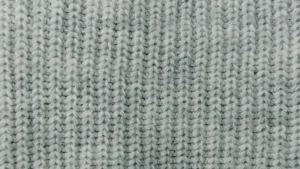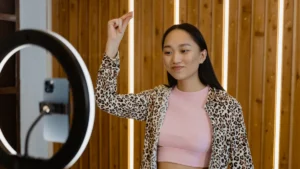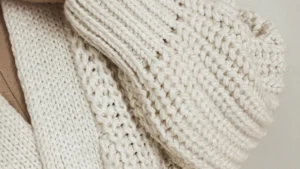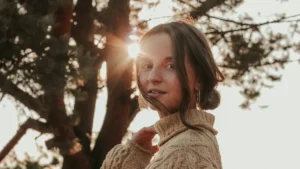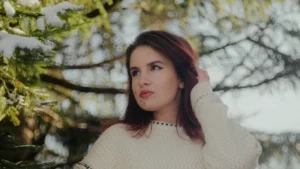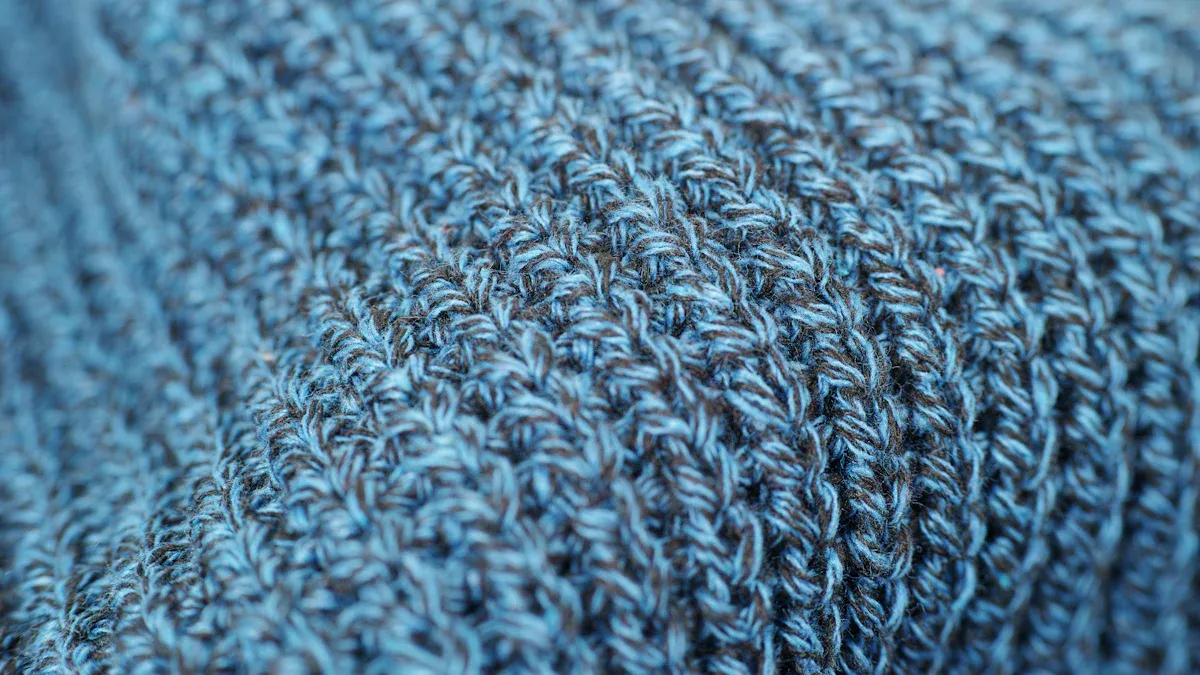
Textured knit fabric is a unique type of knitted fabric characterized by raised patterns or surfaces, setting it apart from smooth fabrics. Knitted fabrics, including textured knit fabric, are known for their excellent stretch and soft feel, making them a popular choice for comfortable clothing. People choose textured knit fabric because it offers versatility and functionality. The construction of knitted fabrics allows air to circulate, helping the fabric breathe and manage moisture effectively. Textured knit fabric is commonly used in many everyday items.
The table below highlights common applications of textured knit fabric in daily life:
Application Category | Examples of Textured Knit Fabric Uses |
|---|---|
Casual Wear | T-shirts, Hoodies, Sweatshirts, Dresses |
Sportswear | Leggings, Cycling Gear |
Innerwear | Briefs, Camisoles |
Winter Wear | Sweaters, Scarves, Cardigans |
Sleepwear | Pajamas, Loungewear |
Accessories | Hats, Socks, Scarves, Gloves |
Children’s Clothing | Baby Blankets, Stretchy Outfits |
Footwear | Shoes, Sneakers |
Home Textiles | Blankets, Cushion Covers, Knit Throws |
Thanks to its comfort, style, and easy care, textured knit fabric remains a favorite choice for both apparel and home textiles.
Key Takeaways
Textured knit fabric has raised patterns and loops. This makes it soft, stretchy, and lets air pass through. It is great for comfy clothes and things for the home.
Different ways of knitting and yarn types make many textures. Some examples are rib, cable, and waffle knits. Each one looks different and has special uses.
The fabric stretches easily and lets air move through. It also moves sweat away and goes back to its shape. This makes it good for sports clothes and daily wear.
Taking care of it is important. Gentle washing and drying flat help keep it soft and strong. This also helps it look nice for a long time.
Textured knits are comfy and stylish. But they can stretch out, get pills, or snag. So, handle them with care and pick the right type for your needs.
Textured Knit Fabric Overview
Definition
Textured knit fabric is easy to spot in textiles. It is made with knitting that forms patterns or raised designs. These designs can include ribbing or other surface features. The fabric is built from loops of yarn. These loops make the fabric soft and stretchy. Special texturing methods, like air-jet texturing, false-twist texturing, and crimping, give the fabric its unique look. These methods help make the fabric feel and look different. The finished fabric is soft, stretches well, and has a special texture.
Note: Knitted fabric structure depends on things like loop length, machine gauge, density, gram weight, and width. These things change how the fabric feels, stretches, and works in daily life.
Parameter | Description |
|---|---|
Loop | The basic part, making the fabric soft and stretchy |
Machine Gauge | How many needles per inch, which changes how fine the fabric is |
Loop Length | How long each loop is, which affects how loose or stretchy it is |
Density | How many loops in a certain length, which shows how open and airy the fabric is |
Gram Weight | How heavy the fabric is for its size, used to compare fabrics |
Width | How wide the fabric is, both total and usable width |
Features
Textured knit fabric has many good features. The looped design lets the fabric stretch a lot. This stretch helps the fabric move with your body. That is why it is great for sportswear and comfy clothes. The open knit lets air flow through the fabric. This keeps you cool and comfortable. The fabric can also pull sweat away from your skin. This helps sweat dry faster.
Scientists test these features using special tests. ASTM D2594 checks stretch. ASTM D737 tests how much air goes through. Wickability tests show how well the fabric moves sweat. Results show textured knit fabric lets more air pass than woven fabric. Airflow numbers are between 256 and 321 mm/s. Looser knits let even more air through because they have bigger holes. Moisture tests show knitted fabrics move sweat faster than woven ones. The fabric also bounces back to shape after stretching, especially with advanced fibers.
Key features of textured knit fabric:
Stretches and bends easily
Lets air pass through well
Moves sweat away from skin
Feels soft and cozy
Returns to shape after stretching
Differences
Textured knit fabric is not the same as woven fabric or smooth knits. Knitted fabrics use loops that link together. Woven fabrics use yarns that cross over each other. This makes the fabrics act differently.
Aspect | Textured Knit Fabric | Smooth Knit Fabric | Woven Fabric |
|---|---|---|---|
Structure | Looped yarns with a textured look | Looped yarns, smooth surface | Yarns cross at right angles |
Stretchability | Extra stretch from the texture | Very stretchy | Not very stretchy |
Softness | Softer and more comfy | Soft and bendy | Stiff and holds shape |
Durability | About the same strength | Stronger, keeps shape longer | |
Breathability | Very airy because of open knit | Also airy | Not as airy |
Appearance | Has texture and patterns | Smooth and plain | Flat with a clear weave |
Knitted fabrics, like textured knits, are softer and stretchier than woven fabrics. The texture adds extra softness and style. Woven fabrics are stronger and keep their shape better. Smooth knits are stretchy and comfy but do not have the extra texture. You should pick the fabric based on if you want comfort, stretch, or strength.
Tip: If you want clothes that move with you and feel soft, choose textured knit fabric. If you need something strong that keeps its shape, pick woven fabric. Smooth knits are comfy but not as interesting to look at as textured ones.
Types of Textured Knit Fabric
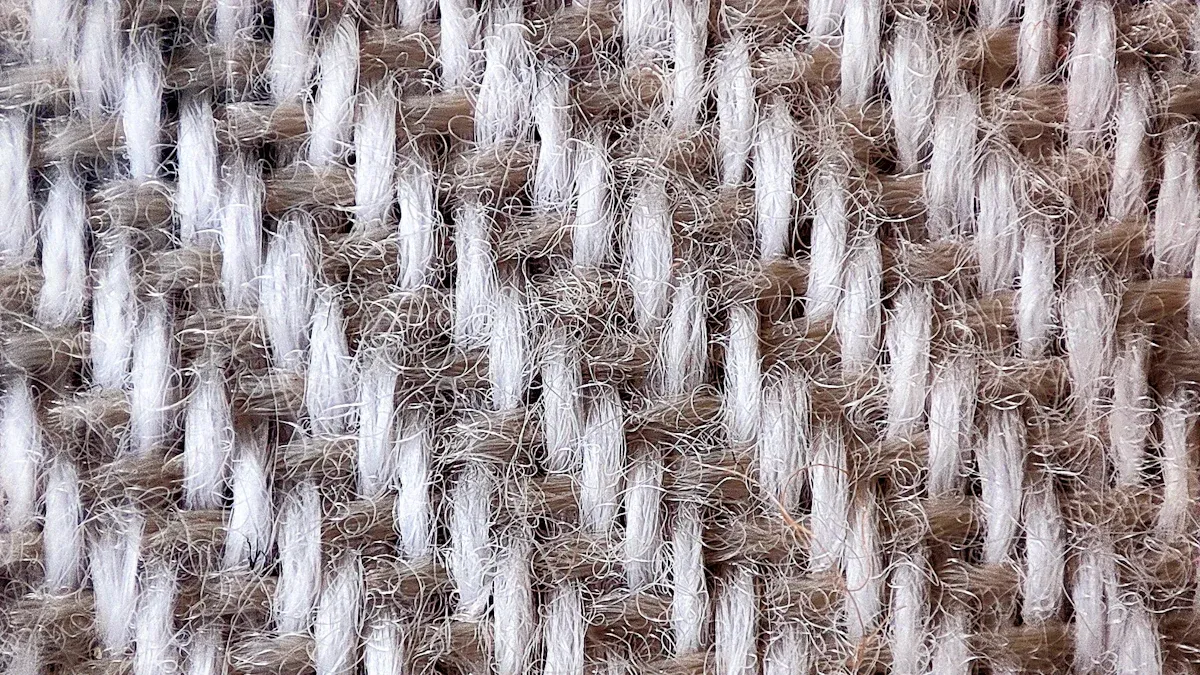
Common Types
There are many kinds of knitted fabrics with special textures. Each kind uses different stitches and yarns for a unique look. Here are some of the most popular types of textured knit fabric:
Rib knit: This fabric has lines that go up and down. It stretches a lot and keeps its shape well. People use rib knit for cuffs, necklines, and hems.
Cable knit: Cable knit makes a raised pattern by crossing stitches. Sweaters and scarves often use cable knit.
Bobble knit: Bobble knit has small, round bumps on the surface. This gives the fabric a fun texture.
Lace knit: Lace knit has open designs that look fancy and light.
Waffle knit: Waffle knit has a surface that looks like a grid. It feels soft and keeps you warm, so it is good for loungewear and thermal tops.
French terry: This fabric has loops on one side and is smooth on the other. It feels soft and soaks up sweat well.
Piqué knit: Piqué knit has a light textured pattern. People often use it for polo shirts.
Slub knit: Slub knit uses yarns that are not even, so the fabric feels bumpy.
Double brushed poly: This fabric feels soft on both sides and does not wrinkle easily. It is great for cozy clothes.
Tip: Picking the right textured knit fabric can make your clothes both comfy and stylish.
Properties
The way textured knit fabric feels depends on the stitch, yarn, and machine. Short stitches make the fabric stiff. Long stitches make it soft. The number of needles per inch changes how thick or thin the fabric is. Circular knitting machines make single knits with even texture.
Knitted fabrics use yarns that loop together. This makes them stretchy and bendy. The fiber also matters. Cotton knits are soft and let air through. Wool knits keep you warm. Synthetic fibers like spandex make the fabric stretch more and last longer. Blended yarns mix the best parts of each fiber.
Type | Texture/Pattern | Common Use |
|---|---|---|
Rib knit | Raised ribs | Cuffs, trims, necklines |
Cable knit | 3D twisted cables | Sweaters, scarves |
Waffle knit | Grid-like, airy | Loungewear, thermals |
Lace knit | Open, delicate | Shawls, light sweaters |
French terry | Loops on one side | Sweatshirts, joggers |
Piqué knit | Subtle textured pattern | Polo shirts |
Texture in knitted fabrics comes from how the stitches make loops and patterns. The yarn, stitch length, and machine type all help make the final fabric. These fabrics can feel soft and smooth or bold and raised. Sweater knit fabric often uses cable or rib patterns to add warmth and style. The many textures and shapes make these fabrics good for clothes and home items.
How Textured Knit Fabric is Made

Making textured knit fabric takes a few main steps. Each step changes how the fabric looks and works. First, you pick the yarn. Then, you use special knitting ways. Last, you finish the fabric to add style and function.
Yarn Selection
Textured knit fabric starts with picking the right yarn. Makers choose yarns from cotton, wool, polyester, nylon, or blends. The fiber type changes how soft, strong, or absorbent the fabric is. Cotton yarns make fabric soft and let air through. Synthetic yarns make it strong and stretchy. Yarn spinning twists fibers together with machines. Sometimes, oils are added to help the yarn stay strong. The yarn’s thickness and twist also change the fabric’s texture.
Note: The yarn you pick decides how stretchy, warm, and nice the fabric looks.
Knitting Techniques
Next comes the knitting step. This step makes loops that give the fabric its shape. There are two main ways: weft knitting and warp knitting. Weft knitting uses one yarn to make loops across the fabric. This way makes soft and stretchy fabric. Rib knits, cable knits, and waffle knits use weft knitting for their textures. Warp knitting uses many yarns to make loops up and down. This way makes fabric that is firm and not as stretchy, like lace and mesh.
Knitting Technique | Yarn Direction | Texture Features | Pattern Complexity | Stability |
|---|---|---|---|---|
Weft Knitting | Horizontal | Soft, stretchy, drapey | Simple to complex | Less stable, more elastic |
Warp Knitting | Vertical | Tight, structured, rigid | Complex, repeatable | More stable, less elastic |
Designers change how loops are made to get different textures. Ribbing pulls the fabric in and makes lines. Lace patterns use holes to make the fabric light. Stranded colorwork adds extra yarn on the back, making it thicker. The knitting can use single jersey, double jersey, or rib knit machines. These machines make different textures and stretch. New machines help keep the texture even.
Ribbing makes the fabric stretchy and bunched.
Lace patterns make open and light designs.
Stranded colorwork makes the fabric thicker.
Cable knits twist stitches to make raised lines.
How you put the stitches and loops together changes the feel and look. Even with the same yarn, different knitting ways make each fabric special.
Finishing
After knitting, the fabric gets finishing steps. These steps make the fabric look and feel better. First, the fabric is washed to clean off oils and dirt. Bleaching and mercerizing make it whiter, stronger, and ready for dye. Dyeing and printing add color and patterns. Heat setting helps the fabric keep its shape and not shrink. Brushing makes the surface soft and fuzzy. Calendering makes it smooth and shiny.
Makers add special finishes to help the fabric work better. Water-repellent finishes help keep rain out. Antimicrobial treatments keep the fabric fresh. UV and flame-retardant coatings make it safer outside or at work. Softening agents make it feel gentle on your skin. Each finish changes how the fabric feels and lasts. Brushing makes it warmer and softer. Chemical finishes add strength and help stop stains.
Quality checks happen at every step. Inspectors check color, weight, stretch, and strength. Machines help find problems fast. These checks make sure every roll of fabric is comfy, looks good, and works well.
Tip: Finishing steps can turn simple knit fabric into strong material for sports, fashion, or home.
Uses and Care for Knitted Fabrics
Applications
Knitted fabrics are used in many parts of life. People wear them as clothes, use them at home, and even as accessories. Designers pick these fabrics for sweaters, dresses, and sports clothes. They are also good for socks, hats, and scarves. At home, people like blankets, cushion covers, and throws made from these fabrics. The soft feel makes them great for pajamas and loungewear. More people want knitted fabrics because they look nice and work well.
Benefits
Knitted fabrics have lots of good points. They stretch and move with your body, so they feel comfy. The open design lets air go through, which keeps you cool. Many people enjoy how soft and warm these fabrics are. Textured knit fabrics made with special yarns feel thick and let more air pass. These things help keep you warm and stop the fabric from wearing out fast. Knitted fabrics can go back to their shape after you stretch them. People want clothes and home items that are comfy, let air in, and are good for the planet. Many brands now use eco-friendly materials, making these fabrics even more popular.
Drawbacks
Even though knitted fabrics are nice, they have some problems:
They can stretch out or get little balls after a lot of use.
Knitted fabrics might not last as long as woven ones.
Sewing them is hard because they stretch a lot.
They can cost more because they need extra steps.
Too much texture can make the fabric lose its shape.
Some fabrics are not as strong, so they do not last as long.
You need to be careful to stop pilling and snags.
The texture can change from one batch to another.
You might see holes, stains, or colors that do not match.
Note: Most people complain about holes, stains, and color changes in knitted fabrics. These problems can make the fabric look bad and not last as long.
Care Tips
Taking care of knitted fabrics helps them last and look nice. Try these tips:
Turn clothes inside out and use a mesh bag to keep them safe.
Use a mild soap and do not use softeners or bleach.
Lay clothes flat to dry so they keep their shape.
Use boxes that let air in and keep clothes clean to stop bugs.
Do not twist or wring the fabric.
Clean stains gently and always check the care label.
If you use harsh cleaners or hot water, you can hurt the fabric. This can make it less soft and fade the color. Washing gently, drying with care, and storing right will keep knitted fabrics soft, bright, and strong for a long time.
Textured knit fabric is popular because it stretches and feels soft. It also has cool patterns that make it special. Factories make these fabrics by looping yarns together. They use modern knitting machines and add special finishes at the end. Knitted fabrics do not wrinkle easily and feel comfy for everyday clothes, sports, and home items. Some types, like rib and pique, are strong, let air through, and are simple to care for. New ideas, like eco-friendly fibers and smart tech, will change how these fabrics are made. You can keep your fabric nice by washing it gently and laying it flat to dry. Trying out textured knit fabrics can make your clothes look better and work well.
FAQ
What makes textured knit fabrics different from regular fabrics?
Textured knit fabrics have raised patterns or unique surfaces. These fabrics use special stitches that create texture. Regular fabrics often feel smooth and flat. People choose textured knit fabrics for their comfort and style.
Can knitted fabrics be used for sportswear?
Yes, many sportswear brands use knitted fabrics. These fabrics stretch and allow air to pass through. Athletes like these fabrics because they help manage sweat. The texture also adds comfort during movement.
How do you prevent knitted fabrics from stretching out?
People should wash knitted fabrics gently and lay them flat to dry. Heavy fabrics need folding instead of hanging. This care helps the fabrics keep their shape and last longer.
Are all textured knit fabrics warm?
Not all textured knit fabrics feel warm. Some fabrics, like waffle or French terry, trap heat. Others, such as lace knit, feel light and cool. The warmth depends on the yarn and the knit pattern.
Why do some knitted fabrics pill or snag easily?
Knitted fabrics can pill or snag because of their looped structure. The texture makes these fabrics softer but also more delicate. Using gentle washing and storing methods helps reduce pilling and snags.



